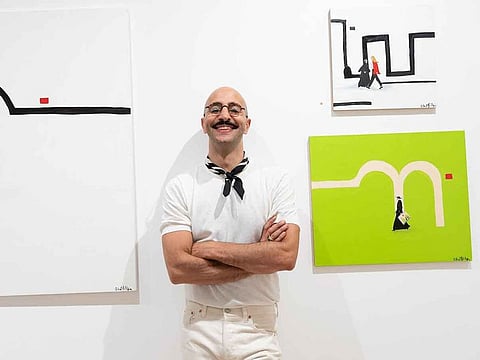Gilbert Halaby’s debut exhibition in Rome merges his Lebanese heritage with Roman inspiration
Lebanese fashion designer-turned-artist reflects on his adopted Roman home and influences

Inside Maja Arte Contemporanea situated on Rome’s charming via Monserrato is a series of 30 vibrantly colored abstract figurative paintings capturing the various exchanges and myriad idiosyncrasies of everyday life in Rome. The works, shown as part of Une Comédie Romaine, Rome-based Lebanese artist and designer’s debut exhibition in Rome. The works on view capture priests, beggars, renowned Italian artists, and personalities that can be found strolling through Rome’s ancient cobblestone streets, each on a different mission of their own yet surrounded by the seductive ruins, buildings, and monuments of the city.
The scenes are at once alluring and captivating: priests donning long black robes ride scooters or bicycles while carrying artworks, nuns stroll through the streets, the drapery of their long robes flowing gently in the breeze, and in other paintings, edgy young and old artists, and Roman personalities, dressed in their own distinctive style, walk elegantly in contemplation through the city. Everyone portrayed has made Rome their home.
Each character is transfixed by Halaby’s gaze that mixes his Levantine origins with his Roman inspiration.
“Almost every afternoon, I sit on my stool outside of my gallery and read; however, I cannot help but be attracted by the passersby and their movements with the Roman background,” says Halaby. “They’ve always inspired me, and I finally decided to depict them on canvases.”
Halay, born and raised in Lebanon, moved to Rome in 2003 after falling in love with the Eternal City. Soon after, he opened a jewelry and handbag store near the Pantheon. In 2010, the Maison Halaby brand launched its first women’s collection and in 2016 he opened his much-loved accessories boutique of specially made leather handbags on Via di Monserrato 21 akin to a cultural salon where the artist also houses many books by contemporary and historic authors and philosophers—the latter being one of his favorite subjects.
Inspiration from his Lebanese homeland has remained vital to both his fashion and accessories business and his artwork—the latter to which he is now devoting most of his time.
Halaby’s love for Rome
While Halaby’s love for Rome is apparent in his new work, on view until July 15, so is his connection with his homeland.
“They reflect my Lebanese heritage through the presence of bright and primary colors and the lack of shadows,” he explains. “I think that is thanks to our Levantine sun.”
Halaby, who grew up and studied in Beirut at the end of the Lebanese civil war, loved to draw and paint watercolors ever since he was a child. It was long his dream to become an artist. Halaby was captivated by the beauty of the natural landscape in Mount Lebanon as a young boy where he would spend long hours playing in the woods amid the olive and pine trees. To this day, the natural landscape of his homeland continues to influence his art.
"Rome has become the painter's adoptive city, where he has been living and working for many years,” art critic Nora Iosia writes of Halaby’s new paintings in the exhibition’s catalogue essay. “The Eternal City is also the cradle of his pictorial research, the place from which he draws inspiration. Its people merge with its architecture's blazing light forming a vision, one that could be called of 'absolute beauty'. It stems from the 'carpe diem' spatiotemporal quality of Rome, its blissful indifference to the passing of time or the changing seasons, a lasting trait, which makes its spaces unique in the world.”
Painted over a period of two years
The works on display in Rome have been painted over a period of two years and are being shown after Halaby’s debut exhibition at Beit Beirut Museum in the Lebanese capital titled Domus Berytus, which took place earlier this year from March 16-30, and captured through Halaby’s abstract painting style the forms of the houses and trees of Mount Lebanon. Halaby, who recalls them while growing up during the Lebanese civil war, calls them “moments of light.”
They are painted with an emotional and poignant mix of abstract forms and lines revealed in bold and muted hues.
The metaphysical jewel of Halaby’s debut exhibition in Rome can be found not only in the endearing painterly style he has endowed to these works, but in their subject matter—the way that they capture the seemingly timeless comedy of Roman life.
What is particular about these scenes is their portrayal of various people from different cultures and backgrounds—all of which have chosen to make Rome their home. The figures are crystallized onto Halaby’s canvases—their movements and gestures forever locked in time.
These works, explains the artist, offer “a true story or comedy, as I call it, it’s life, and it’s composed of all of us.”
‘Une Comédie Romaine’ runs until July 15 at Maja Arte Contemporanea on Via di Monserrato, 30.
Sign up for the Daily Briefing
Get the latest news and updates straight to your inbox



